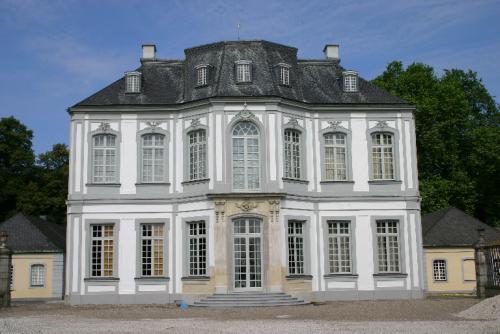
After visiting Prague, I was feeling a little ho-hum, thinking how do we match that. So it was with somewhat less enthusiasm we headed north towards Bruhl to see another Unesco World Heritage site - Schlosser Augustusburg und Falkenlust. It was the summer residence of the Elector Archbishop of Cologne, Clemens August. He commissioned the construction to Francois de Cuvillies starting in 1728 on the site of a medieval moated castle. In the process, Cuvillies enlisted famous artists known throughout Europe to contribute to the exterior and interior design, artwork and the garden complex. Herein lies the beauty of this site. It is a comprehensive work of art representing the best of the late baroque period. There is a unified ordered layout to the palace and the gardens, each complimenting the other. Symmetry is reflected in every aspect of the design and construction. The rococo style, at times, can be overwhelming in the excess of its ornate and flowery presentation. Augustburg managed to achieve a balance between the seemingly ostentatious sculpting on the walls and trim and the spacious grandeur of the rooms. Luxury and elegance is certainly the predominating impression but also artistry in its grandest form. Credit must be bestowed upon the state of North-Rhine Westphalia for recognizing what they had and for the painstaking restoration and maintenance required to make this available in the form we enjoy today. I felt this site deserve special attention for the collective harmonious impact it leaves upon the senses. The ornamentation, stucco work, tapestries, porcelain, frescoes, statues, tiles, woodwork, furnishings, portraits, sculpted marble, iron work, Chinese art and horticulture are tastefully integrated, sufficient to captivate, yet not to overwhelm or detract from its surroundings.
Clemens August was a passionate hunter and it was clear his summer residence was to serve more than just a retreat and reception place for important guests. About 2 kilometers away from the palace, he constructed a hunting lodge known as Falkenlust, meaning falcon bush. As the name suggests, he had an interest in falcons. This served as a retreat as the palace itself was undergoing construction during much of Clemens August's life. Here he would indulge his other interests. Off to the side of the residence were constructed buildings for his falcons and others for horses. A number of these rooms housed fascinating displays and collections of the falcon hunting paraphanaelia.

The grounds of both the palace and the hunting lodge encompassed a considerable tract of land. Trails crisscross the property, with trees centuries old. This wooded parkland provided a pleasant promenade for local residences. We spent a couple hours just walking to the Falconlust and otherwise enjoying the peaceful setting. This was perhaps why this site was so appealing, after having endured the the congested tourist crush of Prague.
Visiting Bruhl brought home the day to day circumstances and life style of the royalty of 18th Century central Germany. Although one could disdain their excess, they also left wonderful legacy's of art. The population was much saddened at the death of the popular prince, as was said "with Clemens August we wore blue and white, and it was just like living in paradise..."
No comments:
Post a Comment